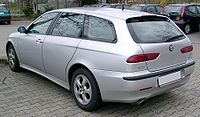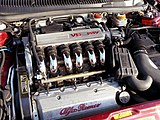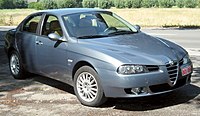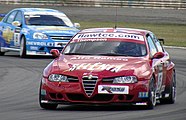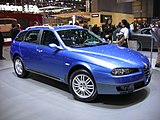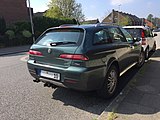Alfa Romeo 156
| Alfa Romeo | |
|---|---|
|
Alfa Romeo 156 sedan (1997-2003)
|
|
| 156 | |
| Production period: | 1997-2007 |
| Class : | Middle class |
| Body versions : | Limousine , station wagon |
| Engines: |
Petrol engines : 1.6–3.2 liters (88–184 kW) Diesel engines : 1.9–2.4 liters (77–129 kW) |
| Length: | 4430-4435 mm |
| Width: | 1743-1745 mm |
| Height: | 1390-1415 mm |
| Wheelbase : | 2595 mm |
| Empty weight : | 1305-1610 kg |
| Previous model | Alfa Romeo 155 |
| successor | Alfa Romeo 159 |
The Alfa Romeo 156 (Type 932) is a middle class - automotive brand Alfa Romeo , which was built by the fall of 1997 until the summer of 2005. The semi-off-road vehicle Crosswagon Q4 , derived from the 156, was sold on the European market until mid-2007. Basis of the construction of the 156 was the platform of the Fiat Tipo , though greatly changed, for example with a double wishbone suspension front and of Lancia derived Camuffo rear axle .
General
The Alfa 156 is considered to be the key model to the new success of the Alfa Romeo brand, after initially stagnating with the new models after the takeover by Fiat in 1986. Just two years after its market launch , the 156 made up over fifty percent of all Alfa production. Around 680,000 copies were made.
The Alfa 156 JTD was the first diesel vehicle with common rail injection . The 156 was probably the first production vehicle to have paints that change color depending on the viewing angle, including the tone "Azzuro Nuvola".
From the slight facelift in spring 2002, there were the equipment variants Impression , Progression and Distinctive .
development
The 156 appeared in September 1997 at the IAA in Frankfurt as a four-door notchback sedan, initially with gasoline engines from 1.6 to 2.5 liters displacement (88 kW to 140 kW) and diesel engines with common rail injection and 1.9 or 2, 4 liters displacement (77 kW and 100 kW). In the 156, magnesium components were used to a considerable extent , and for the first time in an engine of a production vehicle. When series production started, only a small selection of variants was available, which only reached a larger extent in spring 1998 when, for example, vehicles with diesel engines and leather upholstery were delivered.
The magazine “auto motor und sport” compared the fuss about the model in 2015 with the appearance of the Alfa Romeo Giulia 34 years earlier.
In May 2000, after a break of about six years, the 156 Sportwagon , a station wagon from Alfa Romeo, came onto the market again. In contrast to most other station wagons, it is no longer than the sedan.
From mid-2001, the two diesel engines had an output of 85 kW and 110 kW, respectively, because their turbochargers were now equipped with adjustable turbine guide vanes . Shortly afterwards, the sporty 156 GTA with a six-cylinder engine was presented at the IAA in Frankfurt . This model was sold in Germany from April 2002.
In March 2002 there was a slight facelift - new wheels , mirrors and bumper strips in body color, new center console , head airbags as standard in all models - a new 2-liter gasoline engine with direct injection and 122 kW (166 hp) replaced the previous 2.0-liter - Twin Spark , the 2.4-liter diesel, now achieved 110 kW (150 hp) thanks to modified electronics . The 1.9-liter diesel with four-valve technology and 103 kW (140 hp) was available from the end of 2002. Shortly before the model change, the output was increased to 110 kW (150 PS). There was no diesel particulate filter (DPF) for the 156; this was only introduced with the successor 159.
Facelift
In the summer of 2003, Alfa Romeo revised the 156. The chassis and safety were improved, as well as new engines, 129 kW (175 PS) 2.4-liter five-cylinder diesel and 103 kW (140 PS) in the 1.9-liter diesel (later 110 kW (150 PS)) introduced. The shape of the vehicle was redesigned by Giorgetto Giugiaro . The most noticeable changes are the radiator grille and the headlights, the rear has been changed subtly, but with many parts, but is based on the original design. The external changes were not adopted in the GTA.
The special model ti ("Tourismo Internationale") was also offered after the facelift .
At the end of September 2005, the Alfa 156 was replaced by the Alfa 159 . In Egypt, however, the Alfa Romeo 156 will continue to be assembled and sold by the Seoudi Group .
Racing version in the World Touring Car Championship
Body and model variants
When it was launched in autumn 1997, the 156 was initially only offered as a sedan ("Berlina"). The station wagon followed a year later (traditionally known as the Sportwagon ) and in November 2004 the Crosswagon Q4 followed with a higher body.
limousine
The sedan was presented in autumn 1997 and received a lot of attention. In November 2013, Autobild-Klassik described the situation at that time as follows: “The trick with the flunked door handle has been copied by the entire auto industry since 156, but at that time the detail still seemed somehow intellectual and dramatic, so very, very Italian. Also new, but refreshingly retro: the interior. Two round instruments under nozzle-like hoods, that's exactly how Dustin Hoffman roared with the Spider to his Elaine. ”One of the design features of the 156, which was to characterize the following automotive design, were the high belt line. The interior set itself apart from the competition with a subtle retro look, for example in the instruments or the pipe upholstery on the seats. A split folding rear seat bench was not standard. The c W value of the sedan is 0.31.
Sportwagon
After production of the Alfa Romeo 33 Sportwagon ended in autumn 1994, the Alfa Romeo 156 Sportwagon was launched as a new station wagon from Alfa Romeo in May 2000 . Although there had been high-quality station wagons from Mercedes-Benz, for example, that were not aimed at the craftsman clientele, all so-called lifestyle station wagons still had larger load or trunk space, mostly achieved via a long wheelbase, long overhangs and a C-pillar Roofline. When designing the 156 Sportwagon, these ideas were abandoned in favor of a coupe-like silhouette borrowed from Shooting Brakes ; the manufacturer referred to the vehicle as a "station wagon coupé". The wheelbase of the sedan was adopted and the trunk only holds 360 liters, or only 1180 liters after folding down the rear seat. The c W value of the Sportwagon is 0.30.
Auto motor sport described the shape as a fastback and wrote that “the rear view is reminiscent of the forward sloping stern of wooden sailing yachts.” Another article states: “The Alfa Romeo 156 Sportwagon is not a combiner in the traditional sense. He wants to combine coupé elegance with a small but nice plus in practicality. ”The sloping roof line is still a characteristic of almost all modern lifestyle station wagons, but was not adopted in the successor model, the Alfa Romeo 159 Sportwagon.
GTA
Based on the GTA series (Giulia Sprint GTA, GTA 1300 Junior), Alfa Romeo also released a GTA version of the 156 model in 2002.
The 156 GTA, which was available as a sedan and sports wagon, looked even sportier (including redesigned wheels), was equipped differently on the inside (own seats) and had a different drive: as a GTA, the 156 received the last expansion stage of the Arese -V6 -Motor, which is also known as "the last real Alfa engine". This V-engine has a cylinder angle of 60 degrees. In the 156 GTA it is installed across the direction of travel and has the following technical data:
- Displacement: 3179 cm³
- Max. Output: 184 kW (250 PS) at 6200 rpm
- Max. Torque: 300 Nm at 4800 rpm
This engine enables the following performance:
- Top speed:> 250 km / h
- Acceleration 0-100 km / h: 6.3 s
The officially stated consumption values:
- urban: 18.1 l
- extra-urban: 8.6 l
- total: 12.1 l
The aging V6 engine of the GTA has its last use in this model (as well as in the 147 GTA , 166 , GTV , Spider and GT ). Responsible for the end of this engine, in addition to its emissions and consumption behavior, is certainly also the complex production with correspondingly high costs.
The GTA was optionally available with the Selespeed circuit, but this had been modified and improved compared to the "normal" Selespeed circuit. A 6-speed manual transmission was standard.
The GTA was only built with the original front-end module of the 156 series: While the other models received the large grill ( Scudetto ) with the facelift , the GTA retained the small original grill . The GTA was the only version of the Alfa 156 to be delivered with black headlight reflectors.
Crosswagon Q4
The Sportwagon Q4 was a 2 cm higher version of the 156 with all-wheel drive. From October 2004 to July 2007 this was supplemented by the Crosswagon Q4 model , which is 6.5 cm higher. It offers more ground clearance and a better overview without being a full-fledged off-road vehicle. The car has a new type of traction control (ASR) as standard and Alfa's own four-wheel drive "Q4" and can thus be kept better under control even in the limit area. The Crosswagon Q4 can be recognized by the bulky aprons on the front and rear. It was offered exclusively with the 110 kW (150 PS) 1.9-liter four-cylinder diesel engine (305 Nm maximum torque ) in conjunction with a 6-speed manual transmission.
In view of the fact that the successor to the 156 was already expected when it appeared, Alfa Romeo had set the list price at € 32,000, € 2,000 more than the all-wheel drive version Sportwagon Q4 . At 400 units, sales expectations for Germany were also very moderate.
design
Walter Maria de'Silva was responsible for the design , who later designed the Seat Leon II and the Audi A5 , among other things . With the Alfa 156, de'Silva took up a design element typical of Alfa Romeo from the 1950s by pulling the middle part of the radiator grille down and placing the license plate on the side. The handles on the rear doors, which appear to be embedded in the roof pillars, give the four-door model the appearance of a two-door model. Fabrizio Buonamassa, who later became a designer at Bulgari , worked on the interior . Giorgetto Giugiaro was entrusted with the facelift .
The design was classified as future-nostalgic (retro-futuristic), and moved close to the work of Oscar Niemeyer .
landing gear
The wheel suspension of the 156 series is implemented at the front with a lower triangular wishbone and an upper triangular semi-trailing arm. The rear wheels are guided at the top by the shock absorber and at the bottom by two wishbones and a trailing arm ("Camuffo axle"). The upper arms of the front axle were manufactured from aluminum using a vacuum casting process that was new in the automotive industry at the time, which had previously only been used on the rear axle support body of the Alfa GTV / Spider of the 916 series.
The Alfa 156 is one of the rare vehicles with an almost clean Ackermann - front axle geometry . With the Ackermann steering, the front wheel on the inside of the curve is swiveled further than the wheel on the outside of the curve. If the swivel range of a wheel is very limited, this leads to a large turning circle, which all Alfa models had at that time. However, this steering geometry enables cornering without erasing movements with an unusually clean feedback of the road condition in the steering wheel, which makes the steering one of the strongest pluses of this Alfa.
Engines
Petrol engines
| model | Cylinders / valves | Displacement | Max. power | Max. Torque | construction time |
|---|---|---|---|---|---|
| 1.6 TS 16V | 4/16 | 1598 cc | 88 kW (120 PS) | 144 Nm at 4500 min -1 | 09.1997-10.2000 |
| 1.6 TS 16V | 4/16 | 1598 cc | 88 kW (120 PS) | 146 Nm at 4200 min -1 | 10.2000-09.2005 |
| 1.8 TS 16V | 4/16 | 1747 cc | 106 kW (144 PS) | 169 Nm at 3500 min -1 | 09.1997-10.2000 |
| 1.8 TS 16V | 4/16 | 1747 cc | 103 kW (140 PS) | 163 Nm at 3900 min -1 | 10.2000-09.2005 |
| 2.0 TS 16V | 4/16 | 1970 cc | 114 kW (155 PS) | 187 Nm at 3500 min -1 | 09.1997-10.2000 |
| 2.0 TS 16V | 4/16 | 1970 cc | 110 kW (150 PS) | 182 Nm at 3800 min -1 | 10.2000-03.2002 |
| 2.0 JTS 16V | 4/16 | 1970 cc | 122 kW (166 hp) | 206 Nm at 3250 min -1 | 03.2002-09.2005 |
| 2.5 V6 24V | 6/24 | 2492 cc | 140 kW (190 hp) | 222 Nm at 5000 min -1 | 09.1997-10.2000 |
| 2.5 V6 24V | 6/24 | 2492 cc | 141 kW (192 hp) | 218 Nm at 5000 min -1 | 10.2000-09.2005 |
| 3.2 V6 GTA | 6/24 | 3179 cc | 184 kW (250 PS) | 300 Nm at 4800 min -1 | 03.2002-09.2005 |
- TS = T win S park ( double ignition )
- JTS = J et T hrust S toichiometric (gasoline direct injection )
diesel
| model | Cylinders / valves | Displacement | Max. power | Max. Torque | construction time | comment |
|---|---|---|---|---|---|---|
| 1.9 8V JTD | 4/8 | 1910 cc | 77 kW (105 PS) | 255 Nm at 2000 rpm | 09.1997-10.2000 | |
| 1.9 8V JTD | 4/8 | 1910 cc | 81 kW (110 PS) | 275 Nm at 2000 rpm | 10.2000-05.2001 | |
| 1.9 8V JTD | 4/8 | 1910 cc | 85 kW (116 hp) | 275 Nm at 2000 rpm | 05.2001-09.2005 | |
| 1.9 16V JTD M-Jet | 4/16 | 1910 cc | 103 kW (140 PS) | 305 Nm at 2000 rpm | 11.2002-09.2005 | |
| 1.9 16V JTD M-Jet | 4/16 | 1910 cc | 110 kW (150 PS) | 305 Nm at 2000 rpm | 07.2004-07.2007 | only as a Sportwagon and Crosswagon |
| 2.4 10V JTD | 5/10 | 2387 cc | 100 kW (136 hp) | 304 Nm at 2000 rpm | 09.1997-10.2000 | |
| 2.4 10V JTD | 5/10 | 2387 cc | 103 kW (140 PS) | 305 Nm at 2000 rpm | 10.2000-05.2001 | |
| 2.4 10V JTD | 5/10 | 2387 cc | 110 kW (150 PS) | 310 Nm at 1750 rpm | 05.2001-09.2005 | |
| 2.4 20V JTD M-Jet | 5/20 | 2387 cc | 129 kW (175 hp) | 385 Nm at 2000 rpm | 09.2003-09.2005 |
Social relevance
Like many models in the history of the Alfa Romeo brand, the 156 is also considered a vehicle for nonconfirmists. In this role, for example, the vehicle was driven by Claus Theo Gärtner , the film detective Josef Matula in the crime series Ein Fall für Zwei, as well as a 156 Sportwagon by John Malkovich in the lead role as Tom Ripley in Ripley's Game . Even after production was discontinued, the 156 can be seen in films, for example in Tatort - “ Things That Still Need to Do ” from 2012, in trance - Dangerous Memory from 2013 and in A Most Wanted Man from 2014.
Prominent drivers of a 156 as a limousine were or are as diverse as the Austrian artist Adolf Frohner , the Dutch children's book author Dolf Verroen , and the British Transport Minister Stephen Ladyman. Michael Schumacher and the players from the Frankfurt Lions ice hockey club used the Sportwagon .
Awards
The 156 has won numerous international awards over the years. These include the titles Car of the Year 1998 , Auto Europa 1 - 1998 , Best Compact Executive 1998 and The car that I prefer 2000 .
Web links
- Link catalog on the subject of Alfa Romeo at curlie.org (formerly DMOZ )
Individual evidence
- ↑ Alfa Romeo 156 came on the market in 1997 with revolutionary Unijet engines. August 7, 2012, accessed April 4, 2015 .
- ↑ Olaf Twiehaus: Color systems as decision parameters in product marketing, pp. 25–26
- ↑ Burkhard Straßmann: The new cars and their design: Stroll through the International Motor Show in Frankfurt - ZEIT ONLINE. In: zeit.de. September 19, 1997. Retrieved July 17, 2018 .
- ↑ clubalfa.it
- ↑ Auto-Motor-Sport: Generation comparison Alfa Romeo Giulia and 156 Alfas masterpiece and its legacy , accessed on April 3, 2015.
- ↑ Jürgen Pander: Alfa Romeo 156 GTA: Fast Tradition - SPIEGEL ONLINE. In: spiegel.de. June 21, 2001. Retrieved July 17, 2018 .
- ↑ Alfa 156 Facelift: Ciao bel´ ragazzo - auto motor und sport. In: auto-motor-und-sport.de. June 4, 2003. Retrieved July 17, 2018 .
- ↑ Italian fresh cell treatment - autobild.de. In: autobild.de. June 12, 2003. Retrieved July 17, 2018 .
- ↑ Autobild Klassik: A big hit after a dry year in 2013
- ↑ spiegel.de , accessed on April 13, 2015.
- ↑ auto-motor-und-sport.de , accessed on April 3, 2015.
- ↑ auto-motor-und-sport.de , accessed on April 3, 2015.
- ↑ Auto-Motor-Sport: Alfa Romeo 156 Crosswagon Q4 driving report of the all-wheel drive station wagon , accessed on April 3, 2015
- ↑ Birgit Priemer: Walter de Silva: A portrait of Walter de Silva - auto motor und sport. In: auto-motor-und-sport.de. January 19, 2016. Retrieved July 17, 2018 .
- ↑ Bulgai ia all about perfect timing. (No longer available online.) April 1, 2015, formerly in the original ; Retrieved April 4, 2015 . ( Page no longer available , search in web archives ) Info: The link was automatically marked as defective. Please check the link according to the instructions and then remove this notice.
- ^ Paul Andreas, Ingeborg Flagge: Oscar Niemeyer: Eine Legende der Moderne, p. 71.
- ↑ Thomas Jorda: Stolz auf Niederösterreich: at home in the most beautiful country, p. 34, 2003
| Timeline of Alfa Romeo models from 1945 to today | ||||||||||||||||||||||||||||||||||||||||||||||||||||||||||||||||||||||||||||
|---|---|---|---|---|---|---|---|---|---|---|---|---|---|---|---|---|---|---|---|---|---|---|---|---|---|---|---|---|---|---|---|---|---|---|---|---|---|---|---|---|---|---|---|---|---|---|---|---|---|---|---|---|---|---|---|---|---|---|---|---|---|---|---|---|---|---|---|---|---|---|---|---|---|---|---|---|
| Type | Independent until 1933, then state-owned | from 1986 part of Fiat | ||||||||||||||||||||||||||||||||||||||||||||||||||||||||||||||||||||||||||
| 1940s | 1950s | 1960s | 1970s | 1980s | 1990s | 2000s | 2010s | 2020s | ||||||||||||||||||||||||||||||||||||||||||||||||||||||||||||||||||||
| 5 | 6th | 7th | 8th | 9 | 0 | 1 | 2 | 3 | 4th | 5 | 6th | 7th | 8th | 9 | 0 | 1 | 2 | 3 | 4th | 5 | 6th | 7th | 8th | 9 | 0 | 1 | 2 | 3 | 4th | 5 | 6th | 7th | 8th | 9 | 0 | 1 | 2 | 3 | 4th | 5 | 6th | 7th | 8th | 9 | 0 | 1 | 2 | 3 | 4th | 5 | 6th | 7th | 8th | 9 | 0 | 1 | 2 | 3 | 4th | 5 | 6th | 7th | 8th | 9 | 0 | 1 | 2 | 3 | 4th | 5 | 6th | 7th | 8th | 9 | 0 | |
| Small car | MiTo (955) | |||||||||||||||||||||||||||||||||||||||||||||||||||||||||||||||||||||||||||
| Compact class | Arna | |||||||||||||||||||||||||||||||||||||||||||||||||||||||||||||||||||||||||||
| Alfasud | 33 | 145 , 146 (930) | 147 (937) | Giulietta (940) | ||||||||||||||||||||||||||||||||||||||||||||||||||||||||||||||||||||||||
| Middle class | Giulietta Berlina | Giulia | Giulietta (type 116) | 75 | 155 | 156 (932) | 159 (939) | Giulia (952) | ||||||||||||||||||||||||||||||||||||||||||||||||||||||||||||||||||||
| upper middle class | Alfetta | 90 | 164 | 166 (936) | ||||||||||||||||||||||||||||||||||||||||||||||||||||||||||||||||||||||||
| ... | 6C 2500 | 1900 Berlina | 2000 Berlina | 2600 Berlina | 1750/2000 Berlina | Alfa 6 | ||||||||||||||||||||||||||||||||||||||||||||||||||||||||||||||||||||||
| Coupe | Giulietta Sprint | Giulia Sprint GT | Alfasud Sprint | GT (937) | ||||||||||||||||||||||||||||||||||||||||||||||||||||||||||||||||||||||||
| 1900C sprint / super sprint | 2000 sprint | 2600 sprint | 1750/2000 GT Veloce | Alfetta GT / GTV | GTV (916) | Brera (939) | ||||||||||||||||||||||||||||||||||||||||||||||||||||||||||||||||||||||
| Cabriolet | Giulietta Spider | Giulia Spider | Spider ("Duetto") | Spider (916) | Spider (939) | |||||||||||||||||||||||||||||||||||||||||||||||||||||||||||||||||||||||
| 2000 spider | 2600 spider | |||||||||||||||||||||||||||||||||||||||||||||||||||||||||||||||||||||||||||
| Sports car | Disco Volante | Tipo 33 | Montreal | SZ / RZ | 8C Competizione | 4C | ||||||||||||||||||||||||||||||||||||||||||||||||||||||||||||||||||||||
| Off-road vehicle and SUV | Matta | Stelvio (949) | ||||||||||||||||||||||||||||||||||||||||||||||||||||||||||||||||||||||||||
| Vans | Romeo | F12 / A12 | AR6 | |||||||||||||||||||||||||||||||||||||||||||||||||||||||||||||||||||||||||
| AR8 | ||||||||||||||||||||||||||||||||||||||||||||||||||||||||||||||||||||||||||||
|
|
||||||||||||||||||||||||||||||||||||||||||||||||||||||||||||||||||||||||||||


